 |
市場調査レポート
商品コード
1429461
現代戦におけるAI - 市場シェア分析、産業動向と統計、成長予測(2024年~2029年)AI In Modern Warfare - Market Share Analysis, Industry Trends & Statistics, Growth Forecasts (2024 - 2029) |
||||||
● お客様のご希望に応じて、既存データの加工や未掲載情報(例:国別セグメント)の追加などの対応が可能です。 詳細はお問い合わせください。
| 現代戦におけるAI - 市場シェア分析、産業動向と統計、成長予測(2024年~2029年) |
|
出版日: 2024年02月15日
発行: Mordor Intelligence
ページ情報: 英文 125 Pages
納期: 2~3営業日
|
- 全表示
- 概要
- 目次
現代戦におけるAI市場規模は2024年に114億1,000万米ドルと推定され、2029年には448億米ドルに達し、予測期間(2024年~2029年)のCAGRは31.46%で成長すると予測されます。

中国は国防能力を強化するためにAIに賭けており、2030年までにこの分野で世界のリーダーになると予想されています。
主なハイライト
- 大量破壊兵器への需要の高まりが市場成長の原動力となっています。北朝鮮のような国々による核兵器実験の増加も、これらの兵器の成長に寄与しています。これらの兵器は放射性、生物学的、化学的性質を持つため、有害です。
- ISISのような過激派組織が世界中に出現したことで、テロ対策や防衛活動の分野でテクノロジーの利用が重視されるようになった。継続的な実験と研究を通じて、自動運転車両が戦力増強装置として機能することが確認されています。
- 軍事分野で普及しつつある人工知能の大きな動向は、技術改善です。市場の主要企業は、自社の地位を強化するために最先端技術の開発に注力しています。例えば、米国陸軍のTactical Intelligence Targeting Access Node(TITAN)プログラムは、米国の航空宇宙・防衛企業であるレイセオン・テクノロジーズとC3 AIのソフトウェア・アプリケーションの協力により、2022年7月に次世代の機械学習(ML)と人工知能(AI)の能力を獲得します。TITANは、空中および地上のセンサーを使用して高高度および宇宙空間からの情報を取り込み、ターゲットとなる情報と空間認識を提供します。
- AIは多くの国の軍事戦略において重要性を増しているが、欧州連合(EU)と中国はAIの倫理について議論しています。多くの主要な人権団体は、武装ドローンなどの武器の使用は、民間人の死や不法な殺害の増加につながると主張しています。また、規制のないAIが国際的な軍拡競争につながることを懸念する声もあります。
- COVID-19の流行は世界経済に大きな悪影響を与えました。政府の封鎖により、多くの産業が操業停止に追い込まれました。とはいえ、戦闘における人工知能の利用は、こうした前代未聞の状況下で成長することができました。防衛システムをアップグレードするために政府の投資が拡大し、軍事兵器の需要と供給の両方が伸びた。
- 戦闘用人工知能は商業的には成功を収めたが、サプライチェーンの寸断によりサプライヤーから供給される原材料が不足し、総生産量がストップしました。しかし、政府が厳しい制限を緩和すると、市場は成長し、予測期間中に成長すると予想されます。
現代戦におけるAI市場動向
無人航空機が市場を独占する見込み
- 無人航空機(UAV)は、現在のシナリオで実行できる多種多様な操作のため、その登場以来、大きな進歩を遂げてきました。エンジニアはUAVを使用して、以前よりもはるかに高い精度で広範囲にわたって視覚データや熱データを収集することが選択されています。
- 適切なデータ分析により、軍はこの情報を、安全保障と制御、空中偵察、化学・生物・核条件へのアクセス、必要な手順の計画など、さまざまなことに利用しています。
- いくつかの企業がAIを統合したUAVを発売し、市場開拓を後押ししています。例えば、先進的なラストマイル物流の新興企業であるDrone Expressは、マイクロソフトと提携し、飛行中のナビゲーションにAIを使用するDE-2020ドローンの新エディションを2022年12月に発表しました。この革新的な提携は、ドローン配送にマイクロソフトAzureを装備し、AIアプリケーションをホストし、Azure Machine Learningを使用して機械学習モデルを訓練します。AIを搭載したドローンは、都市部で商品を配達するために、飛行中のライブ選択を安全に行うことができます。この技術を搭載した最初の航空機は2022年末に生産が開始され、顧客により安全で迅速なラストマイル・デリバリーの選択肢を提供します。
- また、2022年12月には、人工知能によって制御される軍用機やドローンの「パイロット」を製造するサンディエゴの企業、シールドAIに6,000万米ドルが追加投資されました。
- 空撮技術により、現代のコンピューティングはライブマップによるリアルタイムのドローンマッピングが可能です。その結果、著名企業は人工知能と機械学習を組み合わせて、ドローンが日々取得する何十億枚もの航空写真の形で大量のデータを評価することに注力しています。多くの企業が、アイテム認識と測定システムを使用して現場調査を自動化するソフトウェア・ソリューションを開発しています。この改善は、緊急サービス、災害対応、人道的活動を支援すると期待されています。その結果、新たなブレークスルーは無人航空機セグメントの拡大を加速させると思われます。

北米が大きな市場シェアを占める見込み
- 人工知能は軍事作戦においてますます重要性を増しています。その結果、米国をはじめとする各国はすでに、多様な軍事目的のために数多くのAIアプリケーションを開発しています。
- 2022年12月15日、上院は前週の下院に続き、2023会計年度のジェームズ・M・インホフ国防権限法(NDAA)を承認しました。NDAAは、米国国防総省(DOD)の予算、支出、政策を規定する議会が毎年可決する法令です。2023年版には、国防総省以外の政府機関と国防総省の政府機関の両方について、人工知能(AI)に直接関連する多くのセクションが含まれています。
- ドローン技術は、米国陸軍による重要な発展と、この地域の著名な主な企業による投資の増加によって進歩してきました。軍事用UAVの世界トップメーカーの1つである米国は、この地域での成長を加速させる可能性が高いです。
- 例えば、3月28日に発表された大統領予算では、2023会計年度の必要経費が1兆7,000億米ドル、裁量経費が1,273億米ドルとなっています。この1兆7,000億米ドルのうち、米国国防総省(DOD)の予算は7,730億米ドルで、2022年度の予算より4%増となります。
- さらに、2023年1月に行われた2つの重要な軍事訓練では、米国の空軍調査研究所(AFRL)と英国の国防科学技術研究所(DSTL)が共同で最先端のAI技術を展示しました。この4年間の協力協定は、英米共同の技術的進歩を早め、基礎研究から共同実験に至るまでAI技術を共有し、最終的には両国の全領域の統合制御・指揮能力を強化することを意図しています。

現代戦におけるAI産業の概要
諜報・監視・偵察から攻防のバランス、さらには核兵器システムそのものに至るまで、軍事的要求が高まっているため、市場は緩やかに成長しています。ボーイング、ジェネラル・ダイナミクス・コーポレーション、IBMコーポレーションなどの企業は、人工知能(AI)、ディープラーニング、ロボット工学の進歩を利用して、軍事戦略を変える新たな軍事能力を生み出そうとしています。
2023年1月、ブーズ・アレンは世界にネットワーク化された戦闘空間のためのデータ中心ソリューションを推進しました。友人やパートナーをつなぎ、ミッションクリティカルなデータを戦闘のペースで提供し、強化された暗号化で機密データを保護するために、指揮官はゼロトラスト・ハード化されたプラットフォームを要求しています。そのデータ中心技術は、統合全領域指揮統制(JADC2)戦略の重要な部分であるミッション・パートナー環境(MPE)に役立っています。この戦略の目標は、米国軍と世界中の連合パートナーが同時に同じことを行えるようにすることです。
2022年11月、米国国防総省はアクリート社に対し、同社の脅威検知用AIプログラム「アーガス」の5年間、数百万米ドル規模の生産運用技術ライセンス契約を与えました。
その他の特典:
- エクセル形式の市場予測(ME)シート
- 3ヶ月間のアナリストサポート
目次
第1章 イントロダクション
- 調査の前提条件と市場定義
- 調査範囲
第2章 調査手法
第3章 エグゼクティブサマリー
第4章 市場洞察
- 市場概要
- 業界の魅力度-ポーターのファイブフォース分析
- 供給企業の交渉力
- 買い手/消費者の交渉力
- 新規参入業者の脅威
- 代替品の脅威
- 競争企業間の敵対関係
- 業界バリューチェーン分析
- COVID-19の市場への影響評価
第5章 市場力学
- 市場促進要因
- 大量破壊兵器の成長が現代戦における人工知能の機会を押し上げる
- 政府支出の増加
- 市場抑制要因
- 軍事・防衛分野におけるAIベースのシステム展開に伴う倫理的問題
第6章 市場セグメンテーション
- タイプ別
- 無人航空機
- 無人地上車両
- 戦闘システム
- 回収・整備車両
- 偵察・監視車両
- 地域別
- 北米
- 米国
- カナダ
- 欧州
- ドイツ
- 英国
- フランス
- その他の欧州
- アジア太平洋
- 中国
- 日本
- インド
- 韓国
- その他のアジア太平洋
- その他のラテンアメリカ・中東・アフリカ
- 北米
第7章 競合情勢
- 企業プロファイル
- The Boeing Company
- General Dynamics Corporation
- Alphabet Inc.(Google Inc.)
- IBM Corporation
- Intel Corporation
- Endeavor Robotics
- JSC Kalashnikov Concern
- Lockheed Martin Corporation
- Northrop Grumman Corporation
- FLIR Unmanned Aerial Systems
- Dassault Aviation
- Raytheon Company
- Roboteam Ltd
- SparkCognition Inc.
- Stryke Industries LLC
- Textron Inc.
第8章 投資の展望
第9章 市場機会と今後の動向
The AI In Modern Warfare Market size is estimated at USD 11.41 billion in 2024, and is expected to reach USD 44.80 billion by 2029, growing at a CAGR of 31.46% during the forecast period (2024-2029).

China is betting on AI to enhance its defense capabilities and is expected to become the world leader in this field by 2030.
Key Highlights
- The increasing demand for weapons of mass destruction is driving the market's growth. The growth in the testing of nuclear weapons by countries like North Korea is also contributing to the growth of these weapons. These weapons are radiological, biological, or chemical in nature; therefore, they are harmful.
- The emergence of extremist organizations worldwide, such as ISIS, has led to an increased emphasis on the use of technology in the fields of counterterrorism and defense activities. Through continued experiments and studies, automated vehicles have been identified to act as force multipliers.
- A major trend in artificial intelligence that is becoming popular in the military sector is technological improvement. Major companies in the market are focusing on developing cutting-edge technologies to bolster their positions. For example, the US Army's Tactical Intelligence Targeting Access Node (TITAN) program will receive next-generation machine learning (ML) and artificial intelligence (AI) capabilities in July 2022 thanks to a collaboration between US aerospace and defense corporation Raytheon Technologies and C3 AI's software application. TITAN will use aerial and terrestrial sensors to ingest information from high altitudes and space to deliver targetable information and spatial awareness.
- Although AI is a growing element in the military strategies of many countries, the European Union and China have been engaging in discussions about AI ethics. Many leading human rights organizations argue that the use of weapons, such as armed drones, will lead to an increase in civilian deaths and unlawful killings. Others are concerned that unregulated AI will lead to an international arms race.
- The COVID-19 outbreak had a significant negative impact on the global economy. The government's lockdown caused a number of industries to shut down. Nevertheless, the use of artificial intelligence in combat was able to grow in these unheard-of circumstances. As government investment expanded to upgrade defense systems, both the demand and supply for military weaponry grew.
- Although artificial intelligence in combat was successful commercially, a scarcity of raw materials supplied by suppliers due to disruptions in the supply chain caused a halt in total output. However, once the government relaxes the tight limitation, the market is grew and is expected to grow over the forecast period.
AI In Modern Warfare Market Trends
Unmanned Aerial Vehicles Expected to Dominate the Market
- Due to the wide variety of operations they can perform in the current scenario, unmanned aerial vehicles (UAVs) have made significant strides since their inception. Engineers have been chosen to use UAVs to gather visual and thermal data over large areas with much more accuracy than before.
- With the right data analytics, the military uses this information for many things, such as security and control, aerial reconnaissance, access to chemical, biological, and nuclear conditions, and planning the necessary steps.
- Several businesses launched UAVs with AI integration, which will boost market development. For example, Drone Express, an advanced last-mile logistics startup, teamed with Microsoft to introduce a new edition of their DE-2020 drone in December 2022 that will use AI for in-flight navigation. This innovative cooperation will outfit drone delivery with Microsoft Azure to host AI applications and train machine learning models using Azure Machine Learning. Drones equipped with AI can securely make live, in-flight choices to deliver items in an urban area. The first aircraft equipped with this technology will go into production at the end of 2022, providing clients with safer and speedier last-mile delivery alternatives.
- Also, in December 2022, USD 60 million more was invested in Shield AI, a San Diego company that makes "pilots" for military planes and drones that are controlled by artificial intelligence.
- Through aerial photography technologies, modern computing is capable of real-time drone mapping with live maps. As a result, prominent corporations are focusing on combining artificial intelligence and machine learning to evaluate massive amounts of data in the form of billions of aerial photographs acquired on a daily basis by drones. Many businesses are developing software solutions to automate site investigation using item recognition and measurement systems. This improvement is expected to aid emergency services, disaster response, and humanitarian efforts. As a result, the new breakthrough will accelerate the expansion of the unmanned aerial vehicle segment.

North America is Expected to Hold Significant Market Share
- Artificial intelligence is becoming increasingly important in military operations. As a result, the US and other nations are already developing a number of AI applications for diverse military purposes.
- On December 15, 2022, the Senate approved the James M. Inhofe National Defense Authorization Act (NDAA) for Financial Year 2023 after the House did the week before. The NDAA is an annual statute passed by Congress that specifies the budgets, expenditures, and policies of the United States Department of Defense (DOD). Many sections directly related to artificial intelligence (AI) for both non-DOD and DOD government agencies are included in the 2023 edition.
- Drone technology has progressed due to significant developments by the United States Army and increasing investment by prominent key firms in the region. As one of the world's top makers of military UAVs, the United States is likely to speed up growth in the region.
- For example, the President's Budget, which was unveiled on March 28th, calls for USD 1.7 trillion in required spending and USD 127.3 billion in discretionary spending for Budget Year 2023. Of that USD 1.7 trillion, the U.S. Department of Defense (DOD) will get USD 773 billion, a 4% rise over the appropriations for FY 2022.
- Additionally, at two significant back-to-back military drills in January 2023, the Air Force Research Laboratory (AFRL) of the United States and the Defense Science and Technology Laboratory (DSTL) of the United Kingdom jointly exhibited cutting-edge AI technology. This four-year collaboration agreement intends to hasten joint U.K.-U.S. technological advancement and share AI skills, ranging from fundamental research to cooperative experimentation, eventually enhancing the combined all-domain control and command capabilities of both countries.

AI In Modern Warfare Industry Overview
The market is growing slowly due to increasing military requirements from intelligence, surveillance, and reconnaissance to offense/defense balances and even nuclear weapons systems themselves. Companies like Boeing, General Dynamics Corporation, and IBM Corporation are using advances in artificial intelligence (AI), deep learning, and robotics to create new military capabilities that will change military strategies.
In January 2023, data-centric solutions for the globally networked battlespace were expedited by Booz Allen. To link friends and partners, provide mission-critical data at the pace of battle, and safeguard sensitive data with enhanced encryption, commanders demand a zero-trust-hardened platform. Its data-centered technology has helped with the Mission Partner Environment (MPE), which is a key part of the Joint All-Domain Command and Control (JADC2) strategy. The goal of this strategy is to make sure that the US military and its coalition partners around the world are all doing the same things at the same time.
In November 2022, the US Department of Defense gave Accrete a five-year, multimillion-dollar production operational technology license agreement deal for Argus, the company's AI program for detecting threats.
Additional Benefits:
- The market estimate (ME) sheet in Excel format
- 3 months of analyst support
TABLE OF CONTENTS
1 INTRODUCTION
- 1.1 Study Assumptions and Market Definition
- 1.2 Scope of the Study
2 RESEARCH METHODOLOGY
3 EXECUTIVE SUMMARY
4 MARKET INSIGHT
- 4.1 Market Overview
- 4.2 Industry Attractiveness - Porter's Five Forces Analysis
- 4.2.1 Bargaining Power of Suppliers
- 4.2.2 Bargaining Power of Buyers/Consumers
- 4.2.3 Threat of New Entrants
- 4.2.4 Threat of Substitute Products
- 4.2.5 Intensity of Competitive Rivalry
- 4.3 Industry Value Chain Analysis
- 4.4 Assessment of COVID-19 Impact on the Market
5 MARKET DYNAMICS
- 5.1 Market Drivers
- 5.1.1 Growth in Weapons of Mass Destruction Boost the Opportunity for Artificial Intelligence in Modern Warfare
- 5.1.2 Increased Government Spending
- 5.2 Market Restraints
- 5.2.1 Ethical Issues associated with Deployment of AI-based Systems in Military and Defense
6 MARKET SEGMENTATION
- 6.1 By Type
- 6.1.1 Unmanned Aerial Vehicle
- 6.1.2 Unmanned Ground Vehicle
- 6.1.3 Combat Systems
- 6.1.4 Recovery and Maintenance Vehicle
- 6.1.5 Reconnaissance and Surveillance Vehicle
- 6.2 By Geography
- 6.2.1 North America
- 6.2.1.1 United States
- 6.2.1.2 Canada
- 6.2.2 Europe
- 6.2.2.1 Germany
- 6.2.2.2 United Kingdom
- 6.2.2.3 France
- 6.2.2.4 Rest of Europe
- 6.2.3 Asia-Pacific
- 6.2.3.1 China
- 6.2.3.2 Japan
- 6.2.3.3 India
- 6.2.3.4 South Korea
- 6.2.3.5 Rest of Asia-Pacific
- 6.2.4 Rest of the World (Latin America, Middle East Africa)
- 6.2.1 North America
7 COMPETITIVE LANDSCAPE
- 7.1 Company Profiles
- 7.1.1 The Boeing Company
- 7.1.2 General Dynamics Corporation
- 7.1.3 Alphabet Inc. (Google Inc.)
- 7.1.4 IBM Corporation
- 7.1.5 Intel Corporation
- 7.1.6 Endeavor Robotics
- 7.1.7 JSC Kalashnikov Concern
- 7.1.8 Lockheed Martin Corporation
- 7.1.9 Northrop Grumman Corporation
- 7.1.10 FLIR Unmanned Aerial Systems
- 7.1.11 Dassault Aviation
- 7.1.12 Raytheon Company
- 7.1.13 Roboteam Ltd
- 7.1.14 SparkCognition Inc.
- 7.1.15 Stryke Industries LLC
- 7.1.16 Textron Inc.
